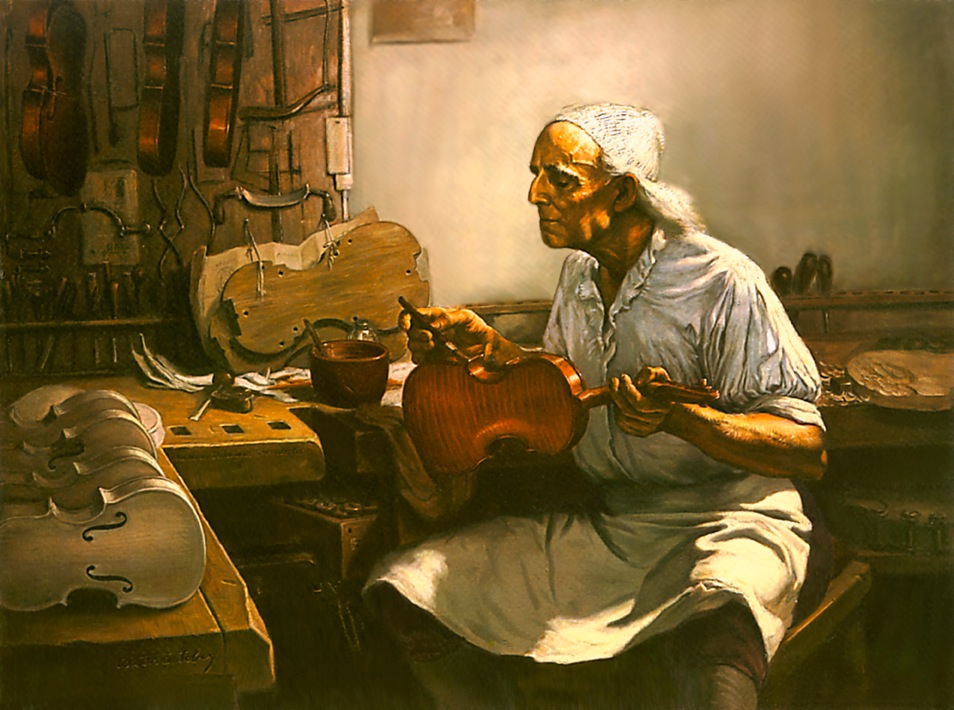
We’ve all heard about the reputation of 17th and 18th-century Italian violins as the pinnacle of bowed string instruments, particularly those made by the great Antonio Stradivari. According to their reputation, the quality of the violins are unmatched, and their sound mystifyingly superior.
A recent comprehensive study has just emerged out of Pierre-and-Marie-Curie University in Paris, France, showing that the supremacy of Strads may be totally unjustified, and in fact, newer violins are the true victors of timbre and playability.
The researchers concluded that a sample of highly respected professional violists, who were systematically prevented from knowing anything about the age of the violin, gave higher marks to the new cheaper violins than the celebrated Italian instruments made centuries ago. This would suggest that the knowledge of the cultural value of the older violins somehow biases the perception of the instruments true quality.
The study is the largest of it kind, and builds upon another study (conducted in 2010) at the International Violin Competition of Indianapolis. This first study looked at 21 violinists, who each played three old and new violins, including two very well-regarded violins made by Stradivari. The results showed that the soloists were unable to decipher the age of the violins, and gave the highest ratings to brand new modern violins, and the lowest rating to those made by Stradivarius.
These results have stumped researchers, and a buzz-storm of debate erupted trying to explain why. Some suggested the study was not comprehensive enough, and dismissed it altogether. Others suggested the study confirmed what they had already suspected – Stradivarius violins are demonstratively substandard to newer violins and thus, overrated.
To help confirm or deny the results of the first study, a new study was designed by researchers who selected six older violins (including five made by Stradivari) and matched them up against six newer ones. Ten soloists were put to the instruments and were asked to select, “the one they’d most like to take on tour with them.” The musicians were given a total of five hours to assess the instruments in two different locations, including a rehearsal room and a concert hall. Some of the soloists also had previous experience playing Stradivari and/or Guarneri “del Gesu” violins, others did not.
According to the published research: “The current study was designed to re-test the Indianapolis findings with a larger number of violins, and then explore how well judgments carry from a small venue to a larger one. Where the Indianapolis study relied on 21 players of various levels, this study concentrated on the judgments of 10 renowned soloists. Blind and double-blind tests were conducted […] With the option of piano accompaniment and listener feedback in the latter.”
The researchers prevented the soloists from knowing the age of the violins by altering the appearance, feel, and scent of the instruments. New violins were altered so that there typical physical attributes would not be indicative of their true age. Musicians also adorned modified welders goggles to diminish their sight, and also played in low light conditions.
The soloists were then given the opportunity to evaluate the violins and rate them according to “a (continuous) scale from 0 to 10 for (1) loudness under the ear; (2) estimated projection; (3) playability; (4) tone quality; (5) articulation/clarity, and (6) overall preference/quality.” They were also asked to choose their top four instruments (ranked on a point scale from 4 for best, and negative 1 for the worst instruments). The worst instruments were those deemed by the first-rate soloists as unsuitable for professional use.
The study showed the overall favorite was a new violin known a “N5.” Garnering a total score of 26 points, it was the top-choice for four soloists, 2nd-choice for another four, and rejected just twice. Second was also a new violin known as “N10”, and was the top-choice for just one soloist, with 13 points. The third place was a Golden Period Stradivari that acquired 11 points. “Though it was top-choice for three soloists and 2nd-choice for one, it was also rejected four times,” the research states.
At the other end of the scale the soloists ranked another Strad and a new violin (“N2” and “N12”) with -7 and -9 points respectively. These scores were based entirely on rejections.
Researchers concluded, “After evaluating the instruments first in a rehearsal room and then in a concert hall, six soloists chose new violins and four chose Stradivari violins. A single new violin was chosen four times, a single Stradivari three times, and two new violins and a Stradivari once each.”
Ratings for individual quality criteria suggest this preference is related mainly to better articulation, playability, and estimated projection – but without trade-offs in timbre. “New violins were on average more highly rated for loudness-under-the-ear, and while this is not necessarily a positive attribute for all players, instruments more highly rated for loudness-under-the-ear were also more highly rated for (estimated) projection – an unquestionably positive criterion for soloists, ” researchers wrote.
Despite testing various means to analyze the results, the researchers could, “find no plausible scoring system by which the old fare any better.” In other words, older violins may have a great deal of historical value, but when compared with modern-made violins, they may not be the zenith of acoustics and feel after all.
Michael Vincent
+++
I’d love to hear from the violinists out there – what do you think?
- THE SCOOP | Royal Conservatory’s Dr. Peter Simon Awarded The Order Of Ontario - January 2, 2024
- THE SCOOP | Order of Canada Appointees Announced, Including Big Names From The Arts - December 29, 2023
- Ludwig Van Is Being Acquired By ZoomerMedia - June 12, 2023



